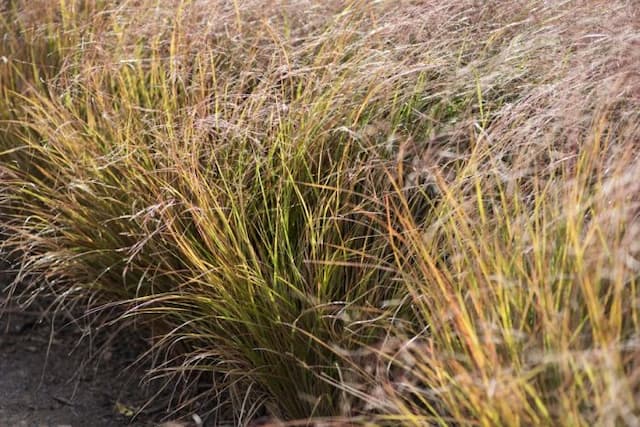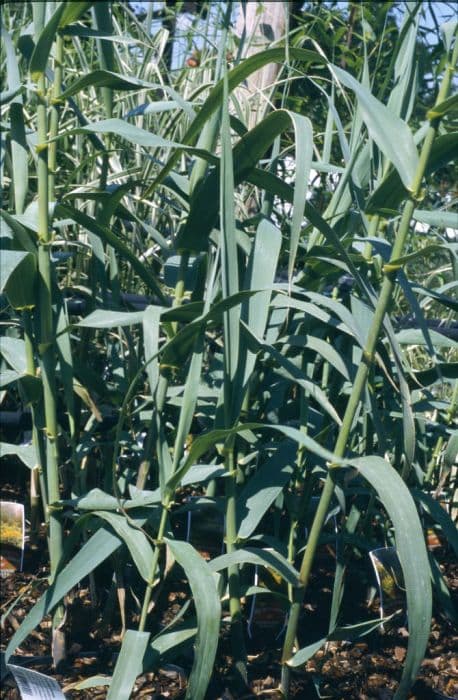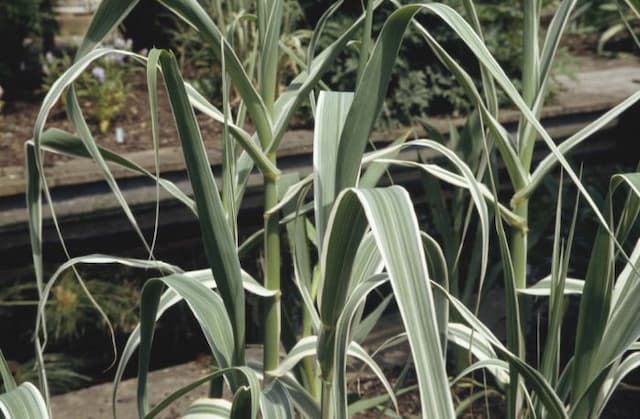Pink Pampas Grass Cortaderia selloana 'Rosea'

ABOUT
Cortaderia selloana 'Rosea', commonly known as Pink Pampas Grass, is a visually striking plant known for its rich plumes of feathery flower heads that exhibit a soft pink hue. These fluffy plumes emerge above a lush mound of arching, narrow leaves that possess a sharp edge. The leaves are typically green, lending a dense and grassy texture to the plant base. Pink Pampas Grass exudes a graceful and elegant appearance, as the plumes gently sway in the wind, creating a dynamic visual effect in any landscape where it's grown. The flower heads usually appear in late summer and persist into fall, often lasting through winter and providing visual interest in the garden for multiple seasons. The overall form of Pink Pampas Grass is rounded, with the flower stems rising vertically, forming a fountain-like shape that is both eye-catching and ornamental. The texture of the plant is varied, with the contrast between the soft flower heads and the more rigid, blade-like foliage creating an appealing aesthetic. This variety of Pampas Grass is often valued for its improved coloration, with the pinkish tones providing a delicate blush that fits well with a variety of planting schemes and color palettes. Pink Pampas Grass is commonly used in landscaping for its striking visual appeal and its ability to serve as a focal point or background plant in garden beds and borders. It is also well-regarded for its adaptability and low maintenance requirements, which combined with its showy appearance make it a popular choice among gardeners and landscapers alike.
About this plant
 Names
NamesFamily
Poaceae
Synonyms
Pink Pampas Grass, Rose Pampas Grass, Pink Feather Pampas Grass
Common names
Cortaderia selloana 'Rosea'.
 Toxicity
ToxicityTo humans
Pampas grass is not considered toxic to humans if ingested. However, the plant's sharp-edged leaves can cause physical injuries, like cuts or irritation to the skin and eyes upon contact. There are no documented symptoms of poisoning from ingestion because it is not known to be poisonous when eaten.
To pets
Similar to its effect on humans, pampas grass is not known to be toxic to pets if ingested. The primary concern is the physical harm that can be caused by the plant's sharp leaves, which can lead to cuts or irritation to the skin, eyes, or mouth if a pet comes into contact with them. There are no specific symptoms of poisoning from ingestion, as it is not recognized as a poisonous plant to pets.
 Characteristics
CharacteristicsLife cycle
Perennials
Foliage type
Evergreen
Color of leaves
Green
Flower color
Pink
Height
6 feet (1.83 meters)
Spread
4 feet (1.22 meters)
Plant type
Grass
Hardiness zones
8
Native area
South America
Benefits
 General Benefits
General Benefits- Ornamental Appeal: Adds visual interest with its tall, feathery plumes and graceful foliage.
- Drought Tolerance: Once established, requires minimal watering, making it suitable for xeriscaping.
- Low Maintenance: Requires little care beyond cutting back old foliage in late winter or early spring.
- Erosion Control: The deep root system helps stabilize slopes and control soil erosion.
- Windbreak: Can be used to reduce wind speeds in gardens and on properties.
- Privacy Screen: Dense growth habit makes it an effective natural screen for privacy.
- Habitat for Wildlife: Provides shelter and nesting sites for birds and other wildlife.
- Adaptability: Tolerates a range of soil types, from sandy to clay.
- Seasonal Interest: Offers year-round interest, with pinkish plumes that persist through fall and winter.
- Tolerance of Coastal Conditions: Resists salt spray and can be planted in coastal environments.
 Medical Properties
Medical PropertiesThis plant is not used for medical purposes.
 Air-purifying Qualities
Air-purifying QualitiesThis plant is not specifically known for air purifying qualities.
 Other Uses
Other Uses- Cortaderia selloana 'Rosea', commonly known as Pink Pampas Grass, can be used in textile production for making paper or packaging materials, due to its fibrous content.
- In garden design, Pink Pampas Grass serves as an architectural plant providing height and structural contrast to low-lying plants and groundcovers.
- The fluffy plumes of Pink Pampas Grass can be used in dried floral arrangements, both for home decor and commercial settings.
- As a natural privacy screen, Pink Pampas Grass can grow tall and dense, providing a visual barrier in residential landscapes.
- The sturdy stems of Pink Pampas Grass can be repurposed as natural stakes for supporting other plants in the garden.
- This plant can serve as a natural windbreak when planted in rows, reducing wind speed in open or exposed areas.
- Pink Pampas Grass can be used in crafting for making eco-friendly decorative items like wreaths and ornaments.
- Biofuel production is another potential use for Pink Pampas Grass, as with many other grass species that have high biomass yields.
- In sound-sensitive areas, Pink Pampas Grass can act as a noise dampener due to its dense foliage, which can absorb and diffuse sound waves.
- Due to its rapid growth and potential for high biomass, Pink Pampas Grass can be explored as a phytoremediation plant to reclaim and improve degraded soils.
Interesting Facts
 Feng Shui
Feng ShuiThe Pampas Grass is not used in Feng Shui practice.
 Zodiac Sign Compitability
Zodiac Sign CompitabilityThe Pampas Grass is not used in astrology practice.
 Plant Symbolism
Plant Symbolism- Beauty in Growth: The Cortaderia selloana 'Rosea', commonly known as Pink Pampas Grass, often symbolizes beauty in growth because of its tall and graceful plumes.
- Elegance: Its slender and flowing appearance can represent elegance and a refined aesthetic.
- Resilience: As a hardy plant that can thrive in various conditions, Pink Pampas Grass stands for resilience and adaptability.
- Privacy: Given its use as a natural screen in landscapes, it can symbolize the desire for privacy or solitude.
- Freedom: The way the plumes of Pink Pampas Grass sway freely in the wind can be associated with freedom and an unrestrained spirit.
 Water
WaterPink pampas grass prefers consistent moisture but it's important not to overwater it. Water the plant deeply once a week, providing it with about 1 to 1.5 gallons of water each time, ensuring that the soil has good drainage to prevent root rot. During hotter and drier periods, water the grass twice a week, but if there's significant rainfall, you can skip the watering schedule that week. In cooler climates or during the rainy season, reduce the watering frequency to when the soil is dry to the touch several inches down. It's crucial to avoid soggy conditions as this can lead to fungal diseases which pink pampas grass is susceptible to.
 Light
LightPink pampas grass thrives in full sun, so the best spot for the plant is in an area where it receives at least six hours of direct sunlight daily. Although it can tolerate partial shade, too little light will result in poorer foliage and fewer plumes. For the healthiest growth and bloom production, position pink pampas grass in a location where it is exposed to unfiltered sunlight for the majority of the day.
 Temperature
TemperaturePink pampas grass is hardy and can withstand a temperature range from about 20°F to over 100°F, making it quite adaptable to various climate conditions. The ideal growing temperatures for pink pampas grass are between 70°F and 80°F. It's quite hardy once established, but young plants should be protected from extreme cold below 20°F.
 Pruning
PruningPink pampas grass should be pruned annually to remove old foliage and make room for new growth. This is best done in late winter or early spring before the new shoots start to emerge. Cut back the grass clumps to about 1 to 2 feet from the ground using sharp, clean shears. It’s also a good opportunity to remove any debris or dead material from the base of the plant. Regular pruning encourages healthful growth and maintains an attractive shape of the pink pampas grass.
 Cleaning
CleaningAs needed
 Soil
SoilPampas Grass prefers a well-draining soil mixture with the addition of sand or perlite to improve drainage and reduce waterlogging, which can be detrimental to its roots. The soil pH should be slightly acidic to slightly alkaline, ranging from 6.0 to 7.5, to support healthy growth.
 Repotting
RepottingPampas Grass is typically not repotted as it is a large, fast-growing plant. It's best to plant it directly in the ground where it has room to expand. However, if grown in a container, it may need repotting every couple of years to manage its size.
 Humidity & Misting
Humidity & MistingPampas Grass tolerates a wide range of humidity levels and is quite hardy in varying environmental conditions. It does well in average humidity and does not require any special humidity adjustments for optimal growth.
 Suitable locations
Suitable locationsIndoor
Place Pampas Grass in a bright area; avoid small spaces due to size.
Outdoor
Full sun, well-drained soil, ample space for growth.
Hardiness zone
7-11 USDA.
 Life cycle
Life cycleCortaderia selloana 'Rosea', commonly known as Pink Pampas Grass, begins its life cycle when its seeds germinate in warm, well-drained soil in late spring to early summer. The seedlings grow rapidly, developing long, narrow, and sharp-edged leaves. In its second year, the plant reaches maturity and produces tall, feathery flower plumes that range in color from pale pink to soft purple, which are often used in dried flower arrangements. These plumes emerge in late summer and last through fall, during which time the plant is pollinated by the wind. After pollination and seed set, the plant goes into dormancy during winter, with the foliage often turning brown but remaining intact. In the spring, new growth resumes from the base of the plant, and the cycle repeats, with older clumps expanding in size each year through vegetative growth.
 Propogation
PropogationPropogation time
Spring to Summer
Propogation: Pampas Grass 'Rosea' is typically propagated through division, which is a popular method for many perennials. The best time to propagate this plant is in late winter or early spring when the plant is dormant and not actively growing. To propagate by division, you should carefully dig up the plant and separate it into smaller sections, ensuring that each section has a portion of the root system intact. These sections can then be replanted in holes that are about twice the width of the root ball, setting the plant at the same depth it was growing previously. Specifically, for Pampas Grass, it is recommended to wear gloves and use a sharp spade or a saw to divide the dense root system. After planting, the divisions should be watered thoroughly to help establish them in their new location.









